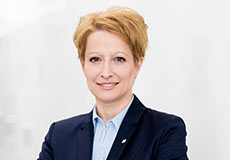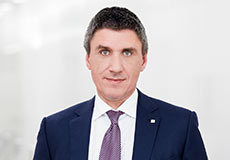Standing tall, thanks to the CEE region.

An interview with the VIG Managing Board about 2015 and future challenges.
At the beginning of the year you began managing the largest insurance group in Austria and the CEE region. Are you going to start with a major change in strategy?
Stadler: No, why change something that has proven its value. VIG is number 1 in its core markets, with a market share of more than 18%, and is well positioned both inside and outside Austria. We are therefore continuing to adhere to VIG’s strategic direction and its dividend policy of distributing at least 30% of net profits. As the new Managing Board team, however, we want to increasingly take advantage of growth opportunities and strengthen the profile of VIG.
Right from the start, however, I would like to stress that we are aware of our high level of corporate social responsibility as an insurance company and we aim to continue fulfilling this responsibility in the future. Our focus is on people, because we provide them with protection from the risks of life and the high costs these can lead to. This is a rewarding function in terms of social policy. But VIG goes even one step further. The Group is well-known in all of its countries for its social involvement.
What role does VIG play as an employer in this respect?
Stadler: I feel it is important for VIG to be considered a secure employer, especially in times like these when we hear of subsidiaries being closed in a wide variety of sectors and businesses having to dismiss employees. Our around 23,000 employees are the main reason for our success. They should be proud of working for a large company with very stable performance. We also consider it our responsibility to foster the talents and skills of our employees, and we in addition support the exchange of cultures and technical information between countries.
Let us turn now to 2015. A year in which the economic conditions continued to be very challenging. How did VIG premium volume perform against this background?
Simhandl: The macroeconomic situation improved in 2015, with primarily some CEE countries recording very good growth rates. At the same time, we also saw a very sharp drop in the price of oil and a very low inflation rate, and, linked to this, the decision by the European Central Bank to start exerting its influence strongly in a low interest rate policy by using quantitative easing. The ongoing low interest rate phase had a negative effect on premium growth in the area of single premium life insurance products. After adjusting for single premium products, however, we achieved good premium growth of 2.2%. Overall, that is very respectable performance in this market environment. In figures, this means that total Group written premiums were EUR 9.0 billion in 2015. Property and casualty insurance grew by 0.8%, health insurance by 3.0% and regular-premium life insurance products recorded an increase of 4.9%.
Let us take a detailed look at the markets …
Simhandl: In Austria, which continues to be our largest individual market, premium volume remained stable compared to the previous year at around EUR 4.1 billion. In the Czech Republic, single premium life insurance declined due to the low level of interest rates, which in turn led to a decrease in premiums. We saw a solid performance in Slovakia. The decrease in Polish life insurance business was due to a focus on profitable business in the area of single premium products. In addition, competition was extremely strong in Poland in the area of motor liability insurance. This had an effect on premium development. VIG continues to be on course in Romania, where all lines of business recorded double-digit growth rates. As always, our Remaining Markets achieved pleasing development with a 12.0% increase in premiums. With respect to the CEE countries, the Baltic countries, Bulgaria, Serbia, Turkey and Hungary achieved particularly significant growth.
The interest rate environment also affects product design, namely life insurance with a guaranteed interest rate. Will you continue to offer this?
Fuchs: Yes. It is a very important unique selling point for insurance. Combining a guaranteed interest rate with a long term allows us to best meet the needs of our customers with respect to risk coverage. We see a need for lifelong pensions over the long term. This is due to the changes occurring in national pension systems. Apart from that, in the area of life insurance we are focusing on risk insurance, and unit-linked and index-linked products.
What effect does the low-interest rate environment have on earnings?
Simhandl: The decrease in the ordinary financial result is essentially due to the ongoing low level of interest rates, which also made it necessary to increase personnel provisions in Austria. This year’s result, however, was also negatively affected by other one-time special effects. These ranged from the EUR 195.0 million write-down of IT systems, to impairments of assets in Romania and Poland. As a result, Group profit before taxes was EUR 172.1 million in 2015.
What does this mean in terms of costs?
Simhandl: Maintaining a continuous focus on costs has always been important to VIG and has helped us avoid major cost-cutting programmes in the past. This is also confirmed by our combined ratio of 97.3%, which is significantly below the 100% mark.
Why was a write-down of IT systems necessary?
Gröll: Three important changes have taken place in recent years. Firstly, the pace of change has accelerated considerably in the insurance market. The times are gone when a product could be developed and then sold for the next five years. Secondly, the legal framework has changed. Solvency II requires even more data than in the past. Disclosure and transparency requirements also significantly increase the demands on IT systems. Thirdly, technological change has to be taken into account. We regularly evaluate the technical usability of our existing systems. Our analyses showed that adjustments are needed in some areas where IT no longer fully satisfies requirements. We therefore decided to make a EUR 195.0 million write-down in this area.
What other steps will you take in terms of IT?
Gröll: We have seen that the rapid pace of change and differences between markets make the idea of uniform IT systems across all business areas, countries and languages unworkable. Group-wide solutions are, of course, reasonable in some areas. The finance area, for example, has Group-wide systems for accounting and asset management. We have, however, clearly seen that individual company requirements differ greatly with regard to insurance portfolio management. IT developments in each market will therefore take account of this in the future.
A brief look at share performance…
Stadler: There is no question that we are completely dissatisfied with a decrease in the price of VIG shares to under EUR 20. The effects of the low interest rate environment on the result, the special effects in 2015 and, not least, the unexpected change in top management have unsettled investors and analysts. We will do everything necessary to gradually win back market confidence and will do our best to provide regular information about the Group and its opportunities and risks.
It has now been 25 years since VIG took the bold step of entering Central and Eastern Europe. How satisfied are you today about your position in these markets?
Fuchs: Around half of our premium income and significantly more than 50% of our profit come from the CEE region. We can therefore be very satisfied with our position, and now that the strategy is bearing fruit, we will, as mentioned at the start, also be adhering to the strategy in the future. This is partly because the CEE region is predicted to record significantly higher growth than the saturated markets of Western Europe. However, one should never be satisfied with business results. VIG aims to improve steadily, even if the current environment is difficult and not susceptible to change.
Stadler: This can also be expressed another way: We still have an appetite for more! We have markets with double-digit growth in the CEE region. Insurance penetration there is, in some cases, only one tenth of the Western level. This and the higher level of economic growth are what generates the great potential. For this reason, in the next few months we will be examining the markets from the Baltic area to the Black Sea for further growth potential. Our goal is to increase market share to at least 10% over the medium term in Croatia, Serbia, Hungary and Poland. If it is economically reasonable and possible, we are also open to further acquisitions, particularly if this is more cost-efficient than establishing and developing our own company.
Are all CEE markets providing the same satisfying performance?
Höfinger: We are now present in 25 countries and therefore well diversified. Some markets grow quickly, some more slowly, but we can even this out within the Group. Our decentralised management approach is also important, and allows the Group companies in each country to follow an appropriate strategy that takes advantage of local market conditions.
Isn’t it true that competition and price pressure are also very strong in the CEE region?
Fuchs: No, that is not the case. There are naturally countries where competition is strong – and I am thinking, in particular, about motor liability insurance. But there is sufficient business potential in these countries that is not price-driven. On the contrary, the goal in these areas is to expand the product portfolio, be the first in the market, and make use of all distribution channels to create corresponding customer awareness. Property and casualty insurance and health insurance are among the areas we will be focusing on more strongly.
Höfinger: We follow the principal of healthy sustainable growth. Growth is only sustainable if it is also profitable. This is the only way we can generate further growth in the countries and offer the customer service that is expected of us. We use a selective underwriting policy in areas where the price pressure is irrational, because if margins are inappropriate we intentionally accept decreases in premiums.
And if everything it doesn’t run smoothly in a market?
Höfinger: It is in periods like these that costs are particularly important. Building up alternative distribution channels, combining back office units, or reorganising and optimising the portfolio are options for action.
Gröll: Romania is the best example. The situation was in turmoil there for many years and competition was extreme. We reacted by massively restructuring and preparing for the time when the market recoveres again. That is precisely what is happening now, and we are recording double-digit growth again in Romania.
You also recently recorded strong growth in the Baltic region.
Fuchs: And how! Our life insurance premium volume has more than tripled since 2009. And the non-life business is also recording excellent performance. There is only a handful of players in this market. It was clear to us that we had to invest if we wanted to play a role there. We achieved this in 2016 by establishing Compensa Non-Life and acquiring BTA and Balitikums, and we have now reached a size in this region that has to be taken seriously.
Simhandl: This clearly shows how right it was to put our trust in the CEE region. Many people had made a very negative assessment of the Baltic area after the financial crisis. At the time we believed – and the Baltic countries have now demonstrated – that they could recover from a very difficult situation through the hard work and efforts of the local people.
How do you succeed in a saturated market like Austria?
Stadler: Austria is definitely at a higher and better stage of development compared to the CEE region, but it is below average for the EU in terms of insurance premiums. This is particularly evident in the area of personal and company old-age provision. People are now aware that the state retirement pension will not be able to satisfy our expectations. This opens up enormous opportunities for us as a private insurer to bring products to market that are precisely tailored to the needs of our customers, such as biometric pension products.
Let us move on to the topic of Solvency II. How well is VIG prepared for this? What changes are the new regulations bringing?
Havasi: Solvency II came into force in January 2016 and has far-reaching consequences for the entire European insurance industry in respect of capital requirements and risk management. Combined with increased documentation and reporting requirements, it will lead to better policyholder protection and standardisation of supervisory systems in the EU. VIG has fully implemented the appropriate structures and processes Group-wide and in the holding company within the prescribed time horizon. VIG had a solvency ratio of around 200% under Solvency II, based on our partial internal model. This means VIG is optimally prepared for the new regulatory requirements. Even under Solvency II, we still remain one of the leaders among international insurance groups in terms of solvency.
Why did VIG decide to use a partial internal model?
Havasi: The standard model offers too little detail in many respects. We therefore decided to introduce a partial internal model in order to model VIG’s risk profile as realistically as possible. We are the only insurance group in Austria that has been given group approval by the supervisory authority. In addition to the Austrian companies concerned, the internal model is also being used in the Czech Republic, Slovakia, Poland and Romania. We are now in the first year of real implementation after the general rehearsal in 2015.
Let us now take a look at the future. What are your expectations?
Stadler: The low-interest rate environment is going to continue affecting us for some time, and will also have negative effects on our result. However, we hope that positive economic growth will continue. Trying to achieve higher levels of investment income by making riskier investments is not part of our business model – we will also remain true to our conservative investment policy in the future. Because we want to continue acting in the interests of and for the benefit of all our stakeholders by remaining on “The Safe Side”, in accordance with the title of this newspaper.
Höfinger: We see very good market opportunities for innovative digital products in the future. A good example is Poland, where we can immediately issue a motor-vehicle policy digitally via the barcode on the registration certificate. In Hungary, our customers can purchase travel insurance via SMS. We are also looking increasingly at the subject of assistance, i.e. adding value to our products with additional services. We will now be taking a closer look at whether and how our companies can use such services across markets. However, the rapid pace of technological change and concerns about customer data privacy raise the question of how far insurance companies should go in the direction of digitalisation.
Is product design the key to success?
Havasi: That is too narrow a question. The main concern is how we want to address the new generations, what form of communication to use.
Stadler: We can see a significant change in customer behaviour. Readiness to change providers and price sensitivity have become much more pronounced. Providing a quality service as well as modern communication and distribution channels is therefore extremely important, in order that price is no longer the sole factor used to justify sales. Nonetheless, I am convinced that customers are mainly looking for a reliable partner who invests their funds conservatively. One thing is certain. VIG will do everything it can to maintain its good position in the future for the benefit of its customers, business partners, shareholders and employees.
New to the Managing Board, but part of the team for years
Three new members were added to the VIG Managing Board at the beginning of 2016. All three previously held a variety of management positions in the Group.

Elisabeth Stadler
Elisabeth Stadler is the new General Manager of VIG. Since 1 January 2016, she has also been the first woman to hold the top position at a company in the ATX Index. A qualified actuary, she has held a number of Managing Board positions in insurance companies since 2003. In September 2014, she was appointed General Manager of Donau Versicherung. The same year, she was awarded the honorary title of Professor by Federal Minister Gabriele Heinisch-Hosek for her work in the area of adult education. Elisabeth Stadler comes from Langenlois, Lower Austria.

Judit Havasi
Judit Havasi has worked for the Group since 2000. Her first position was with UNION Biztosító in her home country of Hungary, where she was appointed head of the Internal Audit department in 2003. Judit Havasi was a member of the Wiener Städtische Austria Executive Committee of the Vienna Insurance Group and a member of the Managing Board of UNION Biztosító in Hungary before her appointment to the Managing Board of Wiener Städtische in 2009. She was Deputy General Manager of Wiener Städtische from July 2013 to the end of 2015, and deputy member of the Vienna Insurance Group Managing Board from 2011. A trained lawyer, she has been a member of the Vienna Insurance Group Managing Board since the beginning of 2016.

Roland Gröll
Roland Gröll studied at the Vienna University of Economics and Business and joined the Wiener Städtische Finance and Accounting department in 1994. He became deputy head of the Finance and Accounting department in 2003 and subsequently became head of the department, which he led from 2008 until the end of 2015. Moreover, Roland Gröll was a member of the Managing Board of Donau Versicherung for two years. He has been a member of the Vienna Insurance Group Managing Board since January 2016.
